Let’s be real, Upper Dolpo trek is not a leisurely stroll in the Himalayas.
It’s raw, remote and immaculately beautiful.
But it’s also a trial that will test you; in the physical sense, mentally challenging and sometimes even emotional capacity.
You will experience all of this at elevations over 5,000m, sleeping outside and relying on our food supplies for days at a time and going days without Wi-Fi or phone signals.
Sound tough?
Yeah, it is!
The trek is one of the most rewarding experiences in Nepal for those who want to challenge themselves.
Quick answer: The Upper Dolpo trek difficulty is categorized as strenuous.
It has long days, high altitude and basic conditions, which are perfect for trekkers with previous experience and a good fitness level.
If you’re still wondering whether you’ll be able to handle the trek, keep reading this guide by Bold Adventures Nepal, as we will cover:
What makes the Upper Dolpo trek challenging?
How to prepare your body and your mind?
When the Upper Dolpo trek altitude hits hardest and how to remain safe?
Travel tips from our guides have done this trek dozens of times.
This is not just another trail guide; it’s the no-nonsense, everything you need to know, simplified for trekkers just like you.
We are ready to reveal the difficulty level of Upper Dolpo, step by step.
Understanding the Upper Dolpo Trek Difficulty Level
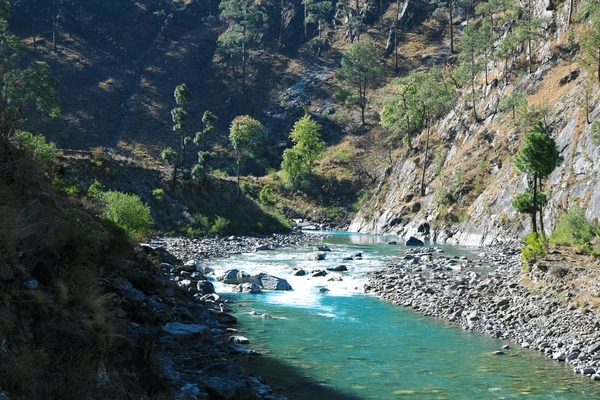
What does it really mean to be “difficult” when trekking?
It is not always a matter of the terrain being steeper or the elevation being higher.
Trekking difficulty is a product of multiplying factors, including total elevation gain, day-to-day trekking distance and duration, trail solitude and your own physical and mental preparation.
The Upper Dolpo Trek difficulty level is rated “strenuous”.
It is not for beginner or novice trekkers.
The wilderness is wild. The days will be long. And the amenities? Forget about it.
But if you are game, you will never regret completing this trek in your lifetime.
What Makes a Trek Difficult? Key Variables to Consider
So how is Dolpo different than some of the more common treks such as Annapurna Base Camp or the Langtang Valley trek?
Factor 1 – Physical Conditioning
You will be hiking for at least 5 hours per day, depending on the day, sometimes (6 hours +).
You will encounter difficult climbs well over mountain passes in the sun with no chance to take a shortcut.
Pro Tips – Train for a mountain marathon, do solid leg strength exercises, cardiorespiratory endurance and even practice with a loaded pack.
Factor 2: High Passes and Altitude Gain
In Dolpo, you will be above 5,000 meters more than once.
That means less oxygen, a slower pace and higher altitude sickness risks if you neglect the acclimatization process.
Factor 3: Remote Trekking
You won’t find any large towns on the trek.
You will be deep in Dolpo’s hidden valleys, where rescue isn’t instant and you could be days from the nearest road.
Did You Know? Sections of the Upper Dolpo trek route have no mobile coverage for more than a week. You are truly off-grid.
Factor 4: Mental and Emotional Resilience
You will have moments of self-doubt.
It could be the altitude or a cold, long night in the tent.
Or it could be day 14 with no hot shower.
Mental toughness is as important as physical stamina.
Quick Test: Ask yourself – “Will I be calm when things don’t go as expected?”. If yes, you are ready for Dolpo.
In summary
Your Upper Dolpo trek difficulty grade will consist of a mix of altitude, long days, isolated trail and your personal resilience.
Altitude and Elevation Gain: The Biggest Challenge
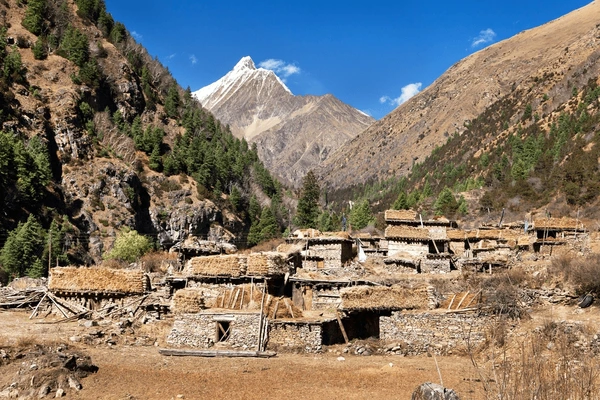
If there’s one thing that stands out about the Upper Dolpo Trek difficulty, it is the altitude.
You’re not going to slowly build your way up to the mountains on this trek.
For days, you will be north of 4,000 meters and have to cross multiple passes that exceed 5,000 meters.
That kind of elevation hits your body hard, especially if you’re not acclimatized.
Why altitudes matter?
The bottom line is that there is less oxygen at a high altitude.
Your body has to work harder in every aspect – to breathe, to walk, to sleep and to think.
If you rush the itinerary or ignore the early symptoms of altitude sickness, it could escalate quickly.
Additionally, the Upper Dolpo trek weather is unpredictable.
Max Elevation Points along the Upper Dolpo Route
Here are the true highs along the trail:
| Section | Max Elevation (meters |
| Kang La ass | 5,160 m |
| Sela La ass | 5,095 m |
| Jeng La ass | 5,090 m |
| Nulungsumda to Saldang Segment | 4,900 – 5,160 m |
These are higher than the Everest Base Camp.
Pro Tip: Our guides have always recommended that you add an extra acclimatization day after crossing the first high pass of the trek. Believe us, it could make or break the rest of your trek.
How to Safely Acclimatize on the Trek?
Here’s how to be smart at altitude on the Upper Dolpo trek:
Tip 1: Go Slow
Follow the Upper Dolpo trek itinerary and don’t take any shortcuts for altitude gain each day.
Tip 2: Schedule Rest Days
Make sure to take at least 2 acclimatization days between 3,500–4,500 m. Don’t skip them, as your body must adjust to the elevation gains.
Tip 3: Drink Water
Dehydration makes acute altitude sickness worse. So, the more you drink water, the more safely you can complete the trek.
Tip 4: Listen to Your Body
Headache? Nausea? Dizziness? Don’t brush it off like it’s nothing. Let your guide know as soon as possible.
Tip 5: Don’t Take Sleeping Pills or Alcohol
You should avoid alcohol, sleeping pills and smoking. They will inhibit breathing while you sleep.
Fun Fact: Diamox is the most common drug to prevent altitude sickness, but it is not a substitute for acclimatization. Consult with your doctor before the trek.
When people ask, “What is the hardest part of the Upper Dolpo trek?”
The answer is simple: It’s not the walk, it’s the altitude.
If you manage it well, it is easy. If you don’t manage it, it may end your trek before you want it to.
Physical Fitness Required for the Upper Dolpo Trek
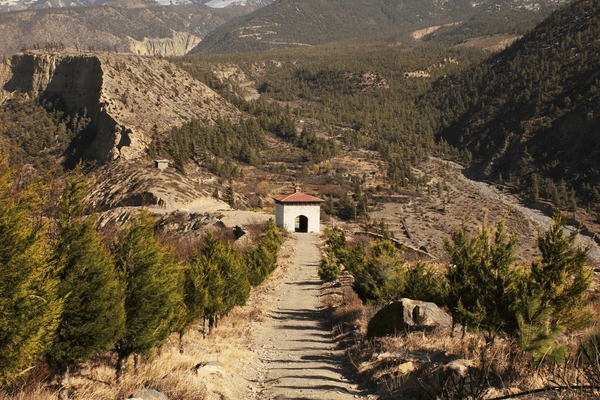
So, just how fit do you need to be for trekking in Upper Dolpo?
Here is the cold, hard truth!
The Upper Dolpo trek is not for the unprepared.
It is long, high, and remote.
The difficulty stems from more than just altitude as well. It’s the physical endurance of trekking day after day in the wilderness.
This is one of the hardest trekking routes in Nepal, and it takes its toll physically and mentally.
How Fit Do You Need To Be?
If you’re a weekend hiker or gym goer, you are off to a good start.
However, from a fitness perspective, trekking in Upper Dolpo, with its long distance, steep climbs and high mountain passes, is a whole different beast!
You should first ask yourself whether you can:
- Walk 6–8 hours each day for more than 20 days.
- Sleep in tents and walk through remote villages with pillaged arrow recovery options.
- Carry your trekking gear or fully rely on porters to carry everything for you.
If you think you can do that, then great.
You can most likely handle the Upper Dolpo trek difficulty.
If you are not sure or don’t think you can do that, then no problem, we are going to help you with a smart prep plan.
Even trekkers with significant experience have reported finding this trail even more difficult than traditional treks like the Annapurna circuit or to Everest Base Camp.
This is primarily the reason why most of our trekkers have chosen to complete the Upper Dolpo trek with a guide, as they can ensure your trek is safer, supported and well-planned.
Recommended Pre-Trek Training Plan
You don’t have to be a marathon runner, but you need to build a consistent level of stamina.
Start your training plan 6–8 weeks before your trek:
- Hike on hills or up stairs with a loaded backpack (5–7kg).
- Leg strength + core workouts (lunges, squats, planks).
- Accompany your training with 2–3 sessions of cardio each week (running, biking, high-intensity interval training).
- Practice “trek conditions” on the weekends, getting out and doing long walks with little rest.
Pro Tip: During your pre-trek training, walk on uneven terrain with the same items from the packing list you will be using for your Upper Dolpo trek, such as shoes and a daypack.
Don’t Forget the Mental Aspect.
Upper Dolpo is not only physically demanding, but it also demands patience, flexibility and mental stamina.
During your trek, you will experience cold mornings, basic foods, tired muscles and days without internet.
As such, it is just as important to develop emotional resilience as fitness.
Terrain Trail Conditions & Daily Trekking Challenges
The Upper Dolpo trek difficulty is not just the elevation, but also what you are stepping on.
Think less trail and more riverbed. Less infrastructure and more wilderness. This is Nepal’s hidden West after all.
You will not find any paved/woodened steps like you would in the Annapurna and Everest region.
The Upper Dolpo trek route provides rocky paths, narrow ridges, loose scree, icy passes and wide plateaus where you can be all alone.
Quick note: For the most part, this trek is within Shey Phoksundo National Park (one of the most remote, protected areas in the entire country).
Remote Trails, Pass Crossings, River Crossings
Here is what you can expect on the trail:
- Unmarked trails with fewer way signs; this requires a licensed guide or a very detailed GPS route.
- Multiple river crossings that are often done on foot or through makeshift bridges.
- High passes such as Kang La (5,160m) and Jeng La (5,090m), where you will notice much less oxygen quantity and snow can happen at any time of the year, even in the fall.
- Minimal human presence; you can go days without seeing another group of trekkers.
Pro tip: Try to plan your trek during dry seasons, such as later spring or fall, so you enjoy clear weather, while also ensuring the trails will be safer to navigate.
Trekking Days, Camping Days & Teahouse Stays
Upper Dolpo is unlike other treks in Nepal, where you benefit from the warm and comfortable teahouses at each stop.
Here’s the breakdown:
Duration of Trek: ~24–26 days
Camping Days: Most nights you will be sleeping in tents, which your trekking team will carry and set up.
Teahouses: Only in a couple of villages (Ringmo, Dho Tarap)
Support Team: You’ll require porters, guides and cooks – this is particularly important when considering the rules for restricted area trekking permits and Upper Dolpo trek.
Did you know? Some sections connect the trail, such as the Rara Lake to Upper Dolpo trek, that have even less infrastructure for stopping, meaning days of camping.
If you are comparing the Upper Dolpo vs Lower Dolpo trek, here’s the truth: the Upper Dolpo is more challenging due to its high altitude and isolated trail.
Every Day Struggles You’ll Have to Prepare for
You should know that there will be days that feel never-ending.
Here are some of the difficulties trekkers generally struggle with:
- Steep elevation gain with high potential for little shade
- The thinner air and short breath
- The complete absence of toilet facilities
- No charging points or phones work
- Your tent will be colder than you imagined – even if it is October
But this is part of what makes the trekking experiences here unforgettable.
Permits, Logistics & Isolation Aspects
One of the main reasons for the Upper Dolpo trek difficulty?
It’s the logistics.
This is not a hop-on-hop-off trek; the Upper Dolpo trek is in an isolated, regulated and rugged area.
Permit, Fees & Travel Constraints
To enter Upper Dolpo, you need to obtain Upper Dolpo trek permits and it’s not cheap.
You will need a restricted area permit, a Shey Phoksundo National Park permit and a TIMS card.
The current cost of the restricted area permit is approximately $500 for the first 10 days and $50 for each day thereafter. (This permit is another reason for the high Upper Dolpo Trek cost.)
The permit for Shey Phoksundo National Park costs around $23 and a TIMS card will cost you around $7.
Given the structure, this means you will have to:
- Hire a licensed trekking guide
- Trek in a group of two or more
- Use a registered trekking agency in Nepal like us.
Limited Access & Rescue Options
Once you are in, you are in.
There are no roads and no reception for many days.
Emergency evacuations can be achieved, but the weather and altitude can delay helicopters.
This is why we always suggest carrying a satellite phone, a well-trained guide and travel insurance with high-altitude rescue coverage.
Seasonal Conditions: When Is the Trek More Difficult?
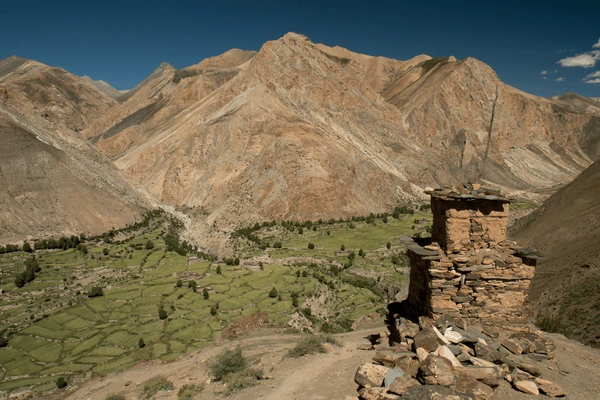
The Upper Dolpo trek difficulty is largely determined by when you go.
Even though Dolpo lies in a rain shadow, its weather has its own set of difficulties, especially at the high altitudes.
Some seasons will have snow. Other seasons will have slippery trails.
Picking the right time will lead to a more enjoyable and safer trek.
Monsoon, Snowfall & Trail Visibility
Here is how each season adds depth in a slightly different way to the difficulty of Upper Dolpo trek:
| Season | Trail Conditions | Difficulty |
| Monsoon | Wet, muddy, overflowing rivers and poor visibility | Very High |
| Autumn | Clear skies, dry trails and best for passes | Moderate |
| Winter | Snow blocks trails and freezing cold nights | High |
| Spring | Melting snow and slippery high passes | High |
Best Time to Trek Upper Dolpo
The majority of trekkers will go trekking in September to early November.
This provides clear weather, a dry Upper Dolpo trek route and easier crossing of high passes like Kang La (5,160 m).
Going for the monsoon or winter?
Expect harsher conditions, particularly on longer routes like the Rara Lake to Upper Dolpo trek or the Upper Dolpo Hidden Valley trek.
Do You Need a Guide for the Upper Dolpo Trek?
If you want to know whether you need a guide for the Upper Dolpo trek, then the answer is definitely YES.
This trek is in the most remote and demanding routes in Nepal and the Upper Dolpo trek difficulty is so high that it should now be attempted without a guide.
It’s not just a matter of physical fitness; it is about being in remote, high-altitude and rugged terrain.
You should also keep in mind that the Dolpo region is a restricted area and you’ll need a licensed guide or a trekking agency to apply for your Upper Dolpo trek permit.
Even more importantly, a guide offers safety, navigation, communication and connection, especially when crossing high passes or when you’re in a remote mountain village where few people speak English and where bad weather may complicate things.
Whether you are hiking the classic Upper Dolpo trek or are stretching the trek route up into the Upper Dolpo Hidden Valley trek, going with a guide is not just a smart decision, but a requirement.
Almost all of our previous trekkers at Nepal Base Camp Trek agree that having an expert guide turns their challenging trek into an experience they will always remember.
FAQs
Is Upper Dolpo harder than the Annapurna Circuit?
Yes, the Upper Dolpo trek difficulty is considered harder than the Annapurna Circuit.
Why?
Because it is longer, more isolated, crosses high passes above 5,000 meters and has far fewer teahouses and facilities than in the Annapurna region.
Can a beginner do the Upper Dolpo trek?
No, the Upper Dolpo trek is not for beginners.
The Dolpo trek difficulty requires good physical fitness, previous multi-day trek experiences and the ability to handle rough and remote terrain.
Before trying Upper Dolpo, beginners should build up their experience by taking easier treks.
What is the hardest part of the Upper Dolpo trek route?
The hardest part includes crossing the Kang La Pass at 5,160 m and the Sela La Pass at 5,095 m.
These days include steep elevation gain and thin air.
How long is the hardest day of the trek?
On average, you will be walking for 7-9 hours, with a steep climb of around 1-2 hours, over high passes (more than 5,000 meters), with a long descent into remote villages.

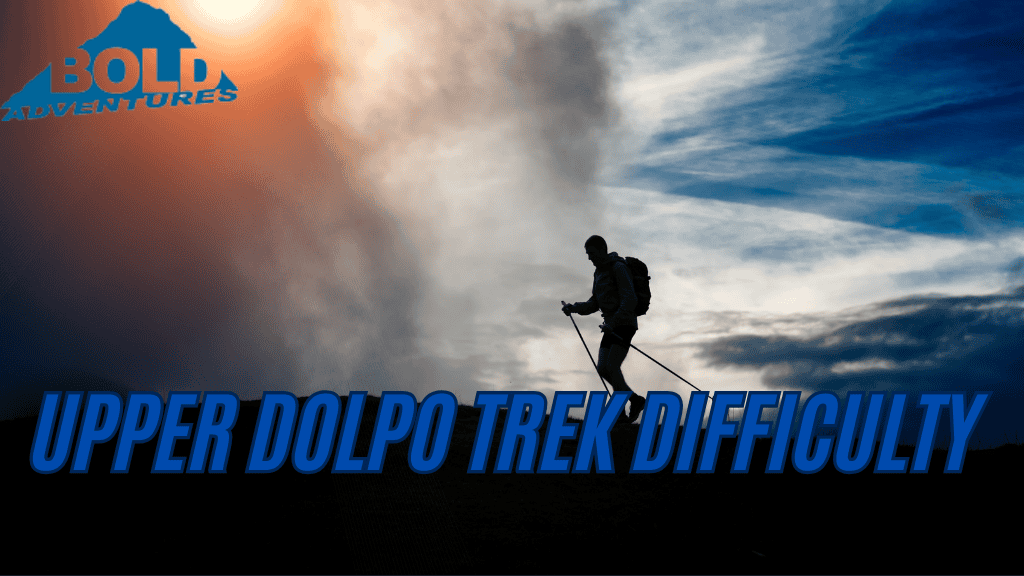
Recent Comments